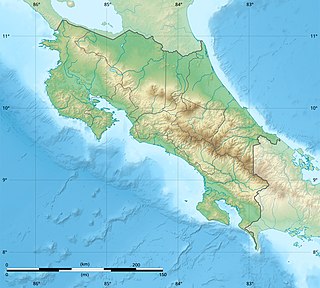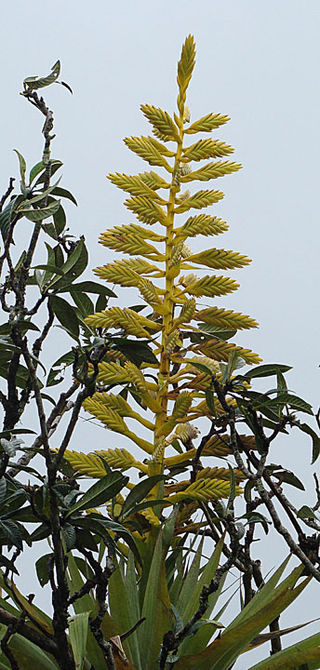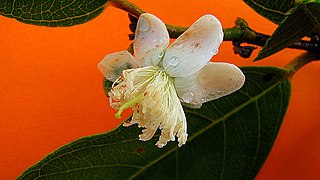
Costa Rica is located on the Central American Isthmus, surrounding the point 10° north of the equator and 84° west of the prime meridian. It has 212 km of Caribbean Sea coastline and 1,016 on the North Pacific Ocean.

Enterolobium cyclocarpum, commonly known as conacaste, guanacaste, caro caro, devil's ear tree, monkey-ear tree, or elephant-ear tree, is a species of flowering tree in the family Fabaceae, that is native to tropical regions of the Americas, from central Mexico south to northern Brazil (Roraima) and Venezuela. It is known for its large proportions, expansive, often spherical crown, and curiously shaped seedpods. The abundance of this tree, especially in Guanacaste Province, Costa Rica, where it is prized for the shady relief it provides from the intense sun, coupled with its immensity, have made it a widely recognized species. It is the national tree of Costa Rica.

Telegonus fulgerator, the two-barred flasher, is a species of spread-wing skipper butterfly in the family Hesperiidae which may constitute a possible cryptic species complex. It ranges all over the Americas, from the southern United States to northern Argentina.

Byrsonima crassifolia is a species of flowering plant in the family Malpighiaceae, native to tropical America. Common names used in English include nance, maricao cimun, craboo, and golden spoon. In Jamaica it is called hogberry.

Peltogyne, commonly known as purpleheart, violet wood, amaranth and other local names is a genus of 23 species of flowering plants in the family Fabaceae; native to tropical rainforests of Central and South America; from Guerrero, Mexico, through Central America, and as far as south-eastern Brazil.

The great green macaw, also known as Buffon's macaw or the great military macaw, is a critically endangered Central and South America parrot found in Nicaragua, Honduras, Costa Rica, Panama, Colombia and Ecuador. Two allopatric subspecies are recognized; the nominate subspecies, Ara ambiguus ssp. ambiguus, occurs from Honduras to Colombia, while Ara ambiguus ssp. guayaquilensis appears to be endemic to remnants of dry forests on the southern Pacific coast of Ecuador. The nominate subspecies lives in the canopy of wet tropical forests and in Costa Rica is usually associated with the almendro tree, Dipteryx oleifera.

Inga is a genus of small tropical, tough-leaved, nitrogen-fixing trees and shrubs, subfamily Mimosoideae. Inga's leaves are pinnate, and flowers are generally white. Many of the hundreds of species are used ornamentally.

Apeiba tibourbou is a tree native to Caatinga and Cerrado vegetation in Brazil, and Costa Rica. It is used as an alternative fiber crop to make paper. It is found in Mexico, Central America, and the northern part of South America.

Ulmus mexicana, the Mexican elm, is a large tree endemic to Mexico and Central America. It is most commonly found in cloud forest and the higher elevations of tropical rain forest with precipitation levels of 2–4 m (79–157 in) per year, ranging from San Luis Potosi south to Chiapas in Mexico, and from Guatemala to Panama beyond. The tree was first described botanically in 1873.

Albizia lebbeck is a species of plant in the family Fabaceae, native to the Indian subcontinent and Myanmar. It is widely cultivated and naturalised in other tropical and subtropical regions, including Australia. Common names in English include siris, Indian siris, East Indian walnut, Broome raintree, lebbeck, lebbek tree, frywood, koko and woman's tongue tree. The latter name is a play on the sound the seeds make as they rattle inside the pods. Siris is also a common name of the genus Albizia.

The sapphire-throated hummingbird is a shiny metallic-green hummingbird found in Panama, Colombia, and more recently Costa Rica. The sapphire-throated hummingbird is separated into three subspecies; Chrysuronia coeruleogularis coeruleogularis, Chrysuronia coeruleogularis coelina, and Chrysuronia coeruleogularis conifis.

Tillandsia oerstediana is a species of flowering plant in the bromeliad family Bromeliaceae. It is an epiphyte that is found on open forested slopes in wet tropical areas. Tillandsia oerstediana is native to Costa Rica and western Panama.

Sterculia apetala, commonly known as the Panama tree, camoruco, manduvi tree or anacagüita, is a species of flowering plants in the family Malvaceae. It is found in Central and South America, as well as the Caribbean islands. Sterculia apetala is recognized as the national tree of the Republic of Panama.

Psidium guineense is a species of guava.
Peltogyne purpurea, commonly known as nazareno, or purpleheart, is a species of Peltogyne tree native to the Pacific coast of Costa Rica and Panama, and also the Atlantic coast of Colombia.

The lesser violetear, also known as the mountain violet-ear, is a medium-sized, metallic green hummingbird species commonly found in forested areas from Costa Rica to northern South America. This species and the Mexican violetear were formerly considered as conspecific and named the 'green violetear'.

Acacia excelsa, also known as ironwood, rosewood, bunkerman and doodlallie is a tree of the genus Acacia and the subgenus Plurinerves that is endemic to inland parts of north-eastern Australia. In the Gamilaraay language it is known as dhan, gayan or gan.

Goethalsia is a monotypic genus of flowering plants belonging to the family Malvaceae. It only contains one species, Goethalsia meiantha(Donn.Sm.) Burret It is within the Grewioideae subfamily.

Euclea gajentaani is a moth in the family Limacodidae. The species was first described by entomologists Marc Epstein and Jorge Corrales in 2004. The species was named for Henricus Gajentaan, Ambassador of the Netherlands to Costa Rica.
Dipteryx oleifera, the eboe, choibá, Tonka Bean or almendro, is a species of emergent rainforest tree up to 165 feet tall in the family Fabaceae, native to Honduras, Nicaragua, Costa Rica, Panama, Colombia, and Ecuador.

















